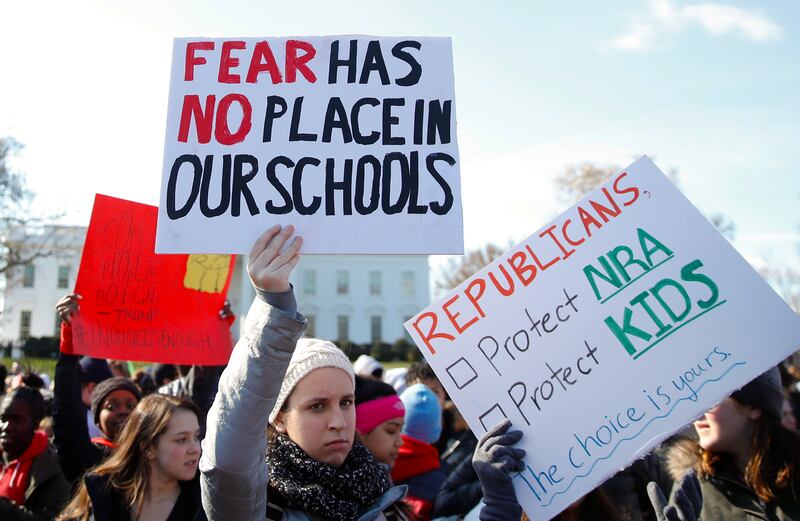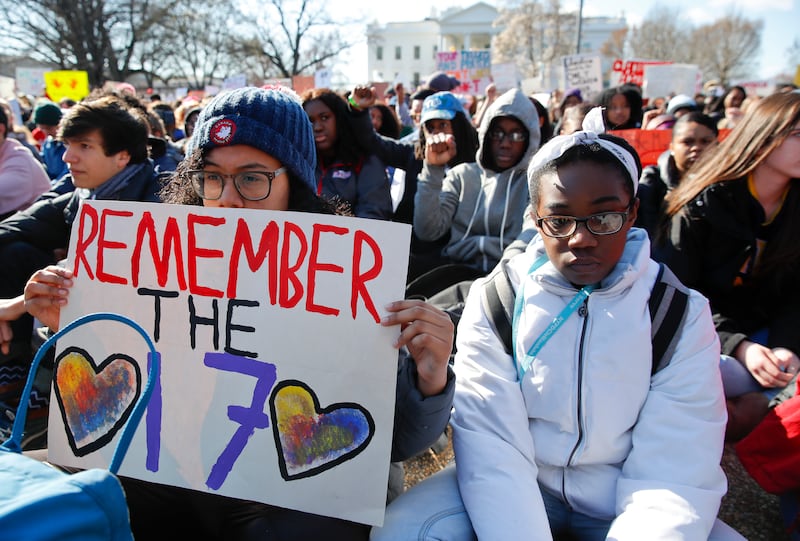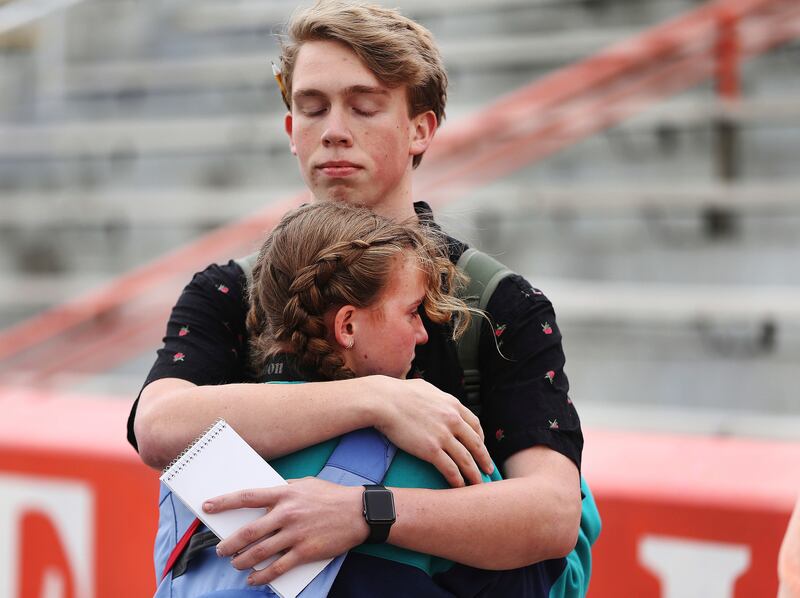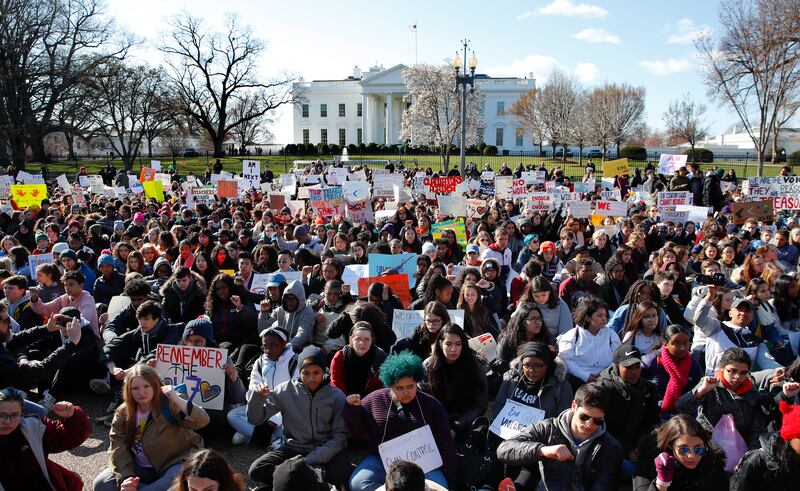More than a million people, including high school students and their families, are expected to swarm the streets of cities around the world Saturday to participate in “March for Our Lives” demonstrations, with the goal of ending school shootings.
“No more silence, end gun violence" and "thoughts and prayers are not enough" are among the chants planned for Salt Lake City’s march, according to the organizers' Facebook page, which has more than 10,000 followers.
“March for Our Lives is created by, inspired by, and led by students across the country who will no longer risk their lives waiting for someone else to take action to stop the epidemic of mass school shootings,” the March For Our Lives mission statement reads.
The marches come on the heels of the largest-ever protest led by high school students, which took place March 14, when students walked out of schools nationwide in honor of the 17 high school students who were killed a month earlier in Parkland, Florida.

The teenagers who are front and center in these protests have already proved they are able to attract media attention and make their voices heard. But will they be successful in creating lasting change? After Saturday’s chanting crowds, impassioned speakers and pithy posters have left the streets, that is the question students will be left to answer.
While the weekend march is focused on gun reform, there's another fight young people are waging in their individual schools. That fight is about social culture, mental health and school safety. In the legislative arena, students are up against the National Rifle Association, one of the most powerful lobbying groups in the country, and in the school arena, they will have to combat entrenched social divides and stigmas about mental health that have fostered violence.
But social movement experts like Cornell University history professor Elizabeth Sanders say that such a large number of young people are involved in these protests has set the movement apart and may help it succeed, despite formidable social and political obstacles.
“There really is something different about this one,” Sanders said.
Salt Lake City’s high school students have already begun to make plans to turn the increased interest in school violence prevention from a moment into a movement. At an event Monday called “Beyond the March,” organized and hosted by the Deseret News, 40 students representing 10 high schools came together to brainstorm ideas for continued action, which ranged from helping graduating students register to vote to being kinder to fellow classmates.
Elizabeth Love, an organizer of Salt Lake’s March For Our Lives and a 17-year-old student at West High School, attended Monday’s event. She said she understands change will not be easy, both in terms of influencing attitudes at her school and pushing for gun reform.

But she doesn’t think it will be difficult to keep American citizens engaged in the issue.
“I don’t think our opposition can count on it dying down anytime soon,” she said. “Because as soon as it dies down, there will be another shooting.”
With another school shooting Tuesday, which left two students, including the shooter, dead and another injured at Great Mills High School in Maryland, Love’s words ring true.
Framing and feeling
Anger and mobilization in response to school shootings have happened before. There have been hundreds of school shooting incidents in recent decades, including 29 mass school shootings, with three or more fatalities, since 1970.
There were protests and groups organized after several of those incidents, including the Columbine High School shooting in 1999 and the Sandy Hook elementary school shooting in 2012. But they led to little in terms of meaningful reform.
“I think there was a certain level of naivete to us 19 years ago. The gun debate was rampant, but it was nowhere near what it is now,” said Columbine survivor Matt Varney, 36, who is proud of the Parkland students for how they’ve responded and wishes that he and his classmates had done more to call upon policymakers. “The students today have grown up not really knowing about Columbine, but knowing school shootings happen frequently. It’s a way of life.”
Students in Utah are now seizing the opportunity to impact the conversation on school safety. At Monday’s event, held at the Utah State Office Building, high schoolers came up with ideas for action, which included helping graduating seniors get registered to vote, rallying behind local candidates who make school safety a priority, organizing school activities that help students reach across social groups and demanding better mental health resources in schools.
“We want to make a difference, and we want it to be a sustainable difference,” said Sam Nafus of Bountiful High School.
Some of the students came up with a list of proposed gun policy changes, including universal background checks, rules that prevent people on the Transportation Security Administration’s no-fly list from buying guns, longer waiting periods and an end to the Dickey Amendment, which has stymied government research into gun violence.
More students, however, focused on ways they could change their own school culture to be more accepting of people’s differences and more supportive of those with mental health challenges, so would-be shooters get help before they act out in violence.

No matter the issue students chose to focus on, all of them recognized that marching wasn’t enough.
“We have to be the innovators,” said Camden Brown, from Bountiful High School. “Then we have to fuel the flame.”
Joseph Grenny, a social scientist and author of books such as “Crucial Conversations” and “Influencer,” encouraged students at the event to approach the problem of school safety from multiple angles and taught them six principles for social influence he has identified through his research.
“Help them love what they hate, help them do what they can’t, provide encouragement, provide assistance, change their economy and change their space,” Grenny said.
The goal of Grenny’s presentation was to help students understand what they would need to do, beyond protesting, to really influence people’s behavior and create lasting change. While Grenny mainly talked in general terms about social movements, he spoke directly to the issue of school shootings when he explained the importance of framing an issue to compel people to act.
“Your opposition will try to frame it to be about freedom or tradition,” Grenny said. “But you’ve got to keep the frame on and stick to your message: This is about kids’ lives.”
That point resonated with Ally Moss, from Lone Peak High School. “If you change the frame, you can change the way people feel,” she said. She wants to focus on sharing the stories of high schoolers who have been directly impacted by school shootings. “If people feel those connections, they will feel more empowered to stand up.”
Behind the scenes
Social movements are most effective when they combine dramatic public demonstrations with quiet work inside political institutions, according to experts like David S. Meyer, a professor of sociology at the University of California, Irvine. Sometimes the people fulfilling each of these roles will disagree, but they must learn to work together, he said.
“We think of the civil rights movement as happening in the streets — but they were also filing legal suits, meeting with lawmakers and lobbying in Washington,” said Stanford University sociology professor Douglas McAdam. “Successful movements don’t get locked into one kind of tactic.”
According to McAdam, getting “locked into one kind of tactic” is precisely what prevented any lasting effect of the “occupy” movement, which started in 2011 and accused big business, the financial industry and government of perpetuating income inequality.
The “Occupy” movement’s approach was to set up and maintain encampments in public places around the world. They attracted a lot of public attention but did not engage with political institutions or established labor parties, McAdam said.
Eventually, the demonstrators got tired and went home.
“If fledgling movements feel nothing is happening, they tend to demobilize,” McAdam said. “Most are unable to sustain the effort.”
Having a clearly defined organization behind a protest can keep the cause from losing relevance after an event takes place, according to University of Wisconsin sociologist Pamela E. Oliver.
“Creating organizational structures that can keep people involved is different from just showing up to protest,” Oliver said.
For example, the civil rights movement was supported by several key organizations and had a strong leader, the Rev. Dr. Martin Luther King Jr. Compare that with the “Women’s March” movement, which was an expression of discontent after the 2016 presidential election and brought an estimated 5 million people to march in Washington, D.C., and around the globe. But it has been less clearly defined and less successful as a result, according to Meyer.
While it took nearly a year for civil rights organizations to plan the 1963 March on Washington, the “Women’s March” was put together in about six weeks with the help of social media and modern technology.
“They did not have the big infrastructure beforehand, so it was kind of like reversing the order,” Meyer said. “It was like, we’ll have the big event and try to build off it.”
He believes the students from Parkland, Florida, have potential to make a more significant impact, since they appear to be building upon a network of experienced gun control advocates, working with groups like the American Civil Liberties Union, the Brady Campaign to Prevent Gun Violence, Everytown for Gun Safety and Moms Demand Action, among others.
“The more I study this stuff, the more I’m impressed with the time it takes for things to happen and how the events that seem like the start are built upon something that took forever,” Meyer said.
Still, it will be hard for students — who don’t vote or give money to political candidates — to change the minds of legislators who are endorsed by the NRA, according to Sanders.
“You are dealing with an extremely powerful opponent,” Sanders said. “They have an enormous pot of money they can pour into campaigns.”
The key, according to McAdam, will be for activists to keep the momentum going and make school safety a deciding issue in the midterm elections coming up in November.
“If politicians worry that they will lose more votes from sticking with the NRA than they gain in votes and contributions, they will shift,” Oliver said.
Young people leading
High school students in Utah and Florida and across the country are already demonstrating their willingness to engage in the political process and work with national organizations.
A gun bill that passed the Florida Legislature earlier this month raised the minimum age for gun purchases, banned bump stocks, allowed for the arming of school personnel and funded school security and mental health resources, among other things. The Marjory Stoneman Douglas High School Public Safety Act — the first gun reform in Florida in two decades — is an early sign that policymakers are not ignoring students’ efforts.
"Today, the House kept its word to the students and families of Marjory Stoneman Douglas High School," said Florida House Speaker Richard Corcoran, a Republican, in a statement reported by NBC News. "When we said 'never again' we meant it."
Cheryl Greenberg, a professor of history at Trinity College, has been inspired by the passion she’s seen from young activists.
“When you’re young you have a kind of idealism and belief you can change the world that adults don’t believe anymore. You put that together with energy and desperation and you can see tremendous things,” she said.
Practical challenges like the inability to vote haven’t stopped Utah’s high school students from adding their voices to the school safety movement.
“We are directly affected by the decisions made concerning these issues,” said Kira Alley, from Bountiful High School, at Monday’s “Beyond the March” event.
“This is our conversation,” said Isaac Reese of Brighton. “Adults need to understand it's our turn to speak.”
But students at Monday's event also acknowledged that involvement in the political arena isn't the only way to create lasting change.
Students talked about ways to recognize fellow students for the good things they are doing: being examples of inclusiveness and unity within their schools, organizing assemblies to teach students suicide prevention skills and self-help techniques and creating space for more honest discussions about dealing with life's challenges.
“It doesn’t have to be on a legislative level. You can be that change,” said Alessa Love, from Westlake High School.
Contributing: Kaylee DeWitt


